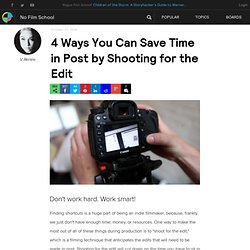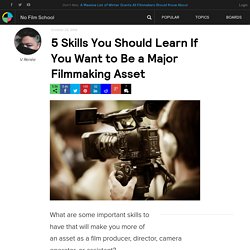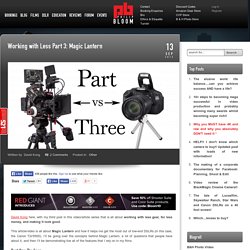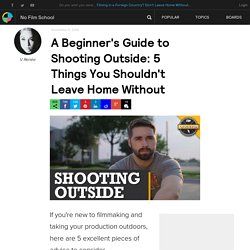

How To Shoot Outside With Modifiers. SMAPP Series (2013) 4 Ways You Can Save Time in Post by Shooting for the Edit. Don't work hard.

Work smart! Finding shortcuts is a huge part of being an indie filmmaker, because, frankly, we just don't have enough time, money, or resources. One way to make the most out of all of these things during production is to "shoot for the edit," which is a filming technique that anticipates the edits that will need to be made in post. Shooting for the edit will cut down on the time you have to sit in an editing bay (or on your couch with your laptop -- whatever), and will basically make your life a whole lot easier. Chris Lavigne of Wistia shares some excellent tips on how to shoot for the edit in the video below: The easy way to shoot food from overhead. This is what I drink every morning.

The juice of carrots, an apple, an orange (preferably blood orange), half a large cucumber, celery, and one veggie not shown, two leaves of Dino kale (I forgot them in the fridge when shooting!) I put them all in a juicer and get about 16-20 oz of this tasty concoction. Its so tasty and so healthy I wanted to do a post in homage to my morning juice – the easy way to do an overhead head shot. Yes, those are purple carrots on the left. 5 Skills You Should Learn If You Want to Be a Major Filmmaking Asset.
What are some important skills to have that will make you more of an asset as a film producer, director, camera operator, or assistant?

There are so many skills and qualities that will no doubt make you a better filmmaker -- even just being an all around nice person does wonders. But Caleb Pike lists five specific skills that he looks for in filmmakers he hires, ones that are not only technical, like staging gear, but ones that are interpersonal. Caleb talks about all five in the video below: So, it's not all about knowing your way around gear. I think we all know at least one individual who is a magician with a camera but has the social graces of a spoiled 5-year-old mid-tantrum. WATCHED. Canon 5D Mark II Basics 101. Working with Less (or, Get Out There and Shoot!) Part 1.
Ok, maybe that photo was a little over the top David Kong here guest-writing this article, the first of a series that is all about working with less gear, for less money, and making it look good.

But I’m going to start off with a big disclaimer that is also a challenge. I’m NOT knocking on quality equipment. The fancy gear is expensive for a reason: it usually is easier to use, is more durable, breaks less often, and just plain gives you better footage. I love to work with high-quality cameras and equipment. Why this is Important First, the ability to work with less gear is essential for the beginner, because you usually just don’t have the money for the fancy stuff. Even for those who can easily afford to spend a lot on top-notch gear, the ability to work creatively with less gear and cheaper gear can benefit you in tons of ways: It’s replaceable. It’s smaller and lighter. You can just save money.
You’re more versatile. Working with Less Part 2: All about the Camera. Viewer question: How did I approach the shoot?

How much did I plan? Viewer question: Did I get signed release forms from everyone in the film? Working with Less Part 3: Magic Lantern. David Kong here, with my third post in this video/article series that is all about working with less gear, for less money, and making it look good.

This article/video is all about Magic Lantern and how it helps me get the most out of low-end DSLRs (in this case, the Canon T2i/550D). I’ll be going over the concepts behind Magic Lantern, a lot of questions that people have about it, and then I’ll be demonstrating live all of the features that I rely on in my films. Part One: The Gear The first video/article was all about the gear (lenses, filters, tripods, etc). If you haven’t seen it yet, check it out here: Part Two: All about the Camera The second video goes very in-depth with the DSLR – I cover everything you need to know about formats, codecs, and dynamic range in order to get the most cinematic images. Part Three: Magic Lantern The Proof of Concept: I’m using one of my films as an illustration for all of these concepts, so if you haven’t seen the Portrait of Macerata, check it out here.
10 Tips for Freelance Filmmakers. A Beginner's Guide to Shooting Outside: 5 Things You Shouldn't Leave Home Without. If you're new to filmmaking and taking your production outdoors, here are 5 excellent pieces of advice to consider.

If you're somewhat experienced in filmmaking, you'll find that these tips from the delightful folks over at Film Riot are pretty standard. Protecting your mics from the wind, always keeping a reflector and ND filter handy, and choosing the optimum time of day to shoot are things you should always keep in mind. However, host Ryan Connolly offers a couple of helpful alternatives for lighting and sound tools that even pros will find nifty. There are countless things to consider before you shoot outside -- and your needs will change dramatically depending on the elements you're facing. I'd say one of the first things you should do before heading out is checking the weather report (something I've learned the hard way). Six Tips For How To Best Shoot Handheld. SMAPP Series (2013)